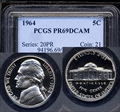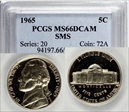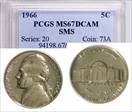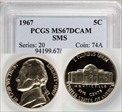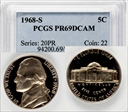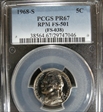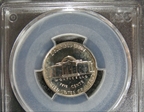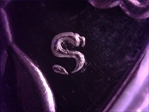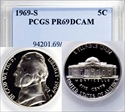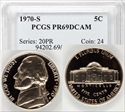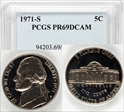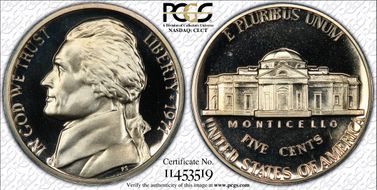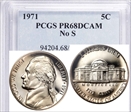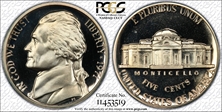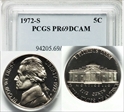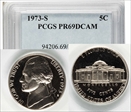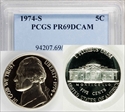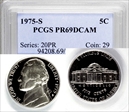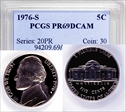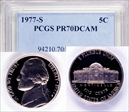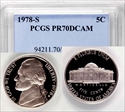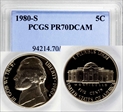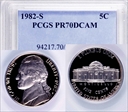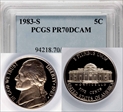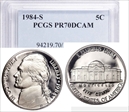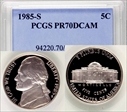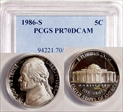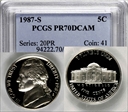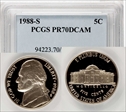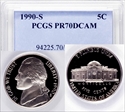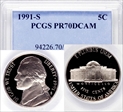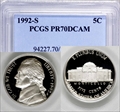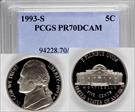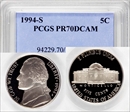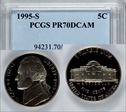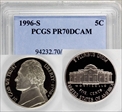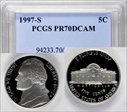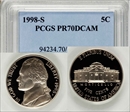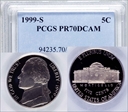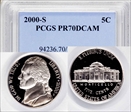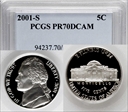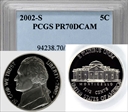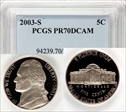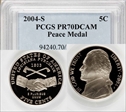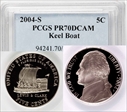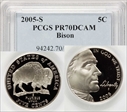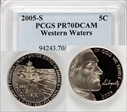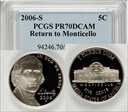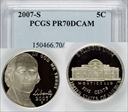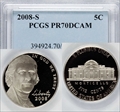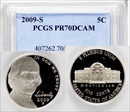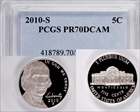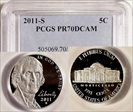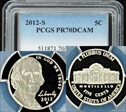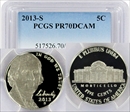Killian Collection - Jefferson Complete Variety Proofs 1938 to Present 的钱币相册
2004-S 5C Peace Medal PR70DCAM PCGS # 94240 : 2004-S Peace Medal (Proof) Mintage: Circulation strikes: 0 Proof Strikes: 2,992,069. Designers: Obverse: Felix Schlag; Initials: (FS) Below Jefferson’s collar, close to rim. Reverse: Norman E. Nemeth; Initials: (NEN) Directly below the cuff of the right arm. Mint: San Francisco Mintmark Location: Obverse below date Composition: Mass 5.000 g (0.1615 troy oz) Diameter 21.21 mm (0.835 in) Thickness 1.95 mm (0.077 in) Edge: Plain Composition 75% copper 25% nickel In commemoration of the Louisiana Purchase, by our third President Thomas Jefferson from Napoleon in 1803, and the ensuing Lewis and Clark expedition, the President enacted Public Law 108-15 in 2003 to modify the Jefferson five-cent coin (nickel). Starting in 2004 and 2005, nickels will reflect images evocative of Meriwether Lewis and William Clark's historic expedition into the Louisiana Territory. The Peace Medal design placed into circulation on March 1, 2004, is a reverse of the original Indian Peace Medal commissioned for Lewis and Clark's expedition. These medals were presented to Native American chiefs and other important leaders as tokens of goodwill at treaty signings and other events. The United States Mint sculptor/engraver Norman E. Nemeth designed the Indian Peace Medal to feature two hands clasped in friendship - one with a military uniform cuff, symbolizing the American government, and the other with a silver band adorned with beads and a stylized American eagle, representing the Native American community. Above the handshake is a crossed axe and peace pipe. The obverse continues to bear the left-facing profile of President Thomas Jefferson that was adapted and designed by Felix Oscar Schlag in 1937 from the marble bust sketched from life by the French sculptor Jean-Antoine Houdon in 1789.
2004-S 5C Keel Boat PR70DCAM PCGS # 94241 : 2004-S Keel Boat (Proof) Mintage: Circulation strikes: 0 Proof Strikes: 2,965,422 Designers: Obverse: Felix Schlag; Initials: (FS) Below Jefferson’s collar, close to rim. Reverse: Al Maletsky; Initials: (AM) Above and to the right of ‘K’ in CLARK. Mint: San Francisco Mintmark Location: Obverse below date Composition: Mass 5.000 g (0.1615 troy oz) Diameter 21.21 mm (0.835 in) Thickness 1.95 mm (0.077 in) Edge: Plain Composition 75% copper 25% nickel In commemoration of the Louisiana Purchase, by our third President Thomas Jefferson from Napoleon in 1803, and the ensuing Lewis and Clark expedition, the President enacted Public Law 108-15 in 2003 to modify the Jefferson five-cent coin (nickel). Starting in 2004 and 2005, nickels will reflect images evocative of Meriwether Lewis and William Clark's historic expedition into the Louisiana Territory. The Keel Boat design, by United States Mint sculptor/engraver Al Maletsky, was placed into circulation in late 2004 and shows an angled side-view of the Keel Boat at full sail with Captains Meriwether Lewis and William Clark in full uniform on the bow. The Keel Boat was used to transport members of the expedition and their supplies through the rivers of the Louisiana Territory in search of a northwest passage to the Pacific Ocean. Built to the specifications of Captain Lewis, the 55-foot keelboat could be sailed, rowed, poled like a raft, or towed from the riverbank. The obverse continues to bear the left-facing profile of President Thomas Jefferson that was adapted and designed by Felix Oscar Schlag in 1937 from the marble bust sketched from life by the French sculptor Jean-Antoine Houdon in 1789.
2005-S 5C Bison PR70DCAM PCGS # 94242 : 2005-S American Bison (Proof) Mintage: Circulation strikes: 0 Proof Strikes: 3,344,679 Designers: Obverse: Joe Fitzgerald; Initials: (JF) Below President Jefferson’s jaw, close to rim. Sculpted by: Don Everhart II; Initials: (DE) Under President Jefferson’s chin, close to rim. Reverse: Jamie N. Franki; Initials: (JNF) Below the hoof of the rear left leg of the bison. Sculpted by: Norman E. Nemeth; Initials: (NEM) Below the hoof of the front left leg of the bison. Mint: San Francisco Mintmark Location: Obverse below Liberty Composition: Mass 5.000 g (0.1615 troy oz) Diameter 21.21 mm (0.835 in) Thickness 1.95 mm (0.077 in) Edge: Plain Composition 75% copper 25% nickel In commemoration of the Louisiana Purchase, by our third President Thomas Jefferson from Napoleon in 1803, and the ensuing Lewis and Clark expedition, the President enacted Public Law 108-15 in 2003 to modify the Jefferson five-cent coin (nickel). Starting in 2004 and 2005, nickels will reflect images evocative of Meriwether Lewis and William Clark's historic expedition into the Louisiana Territory. The “Liberty” inscription on the obverse is based upon Jefferson’s own handwriting. The design is based on the marble bust of Jefferson by the French sculptor Jean-Antoine Houdon, completed in 1789. The design was made age-appropriate to his presidency by utilizing later paintings by Gilbert Stuart and Rembrandt Peale. The new obverse image of President Jefferson replaces Felix Oscar Schlag‘s image of President Jefferson that had been on the nickel since 1938. The design was created by United States Mint Artistic Infusion Program artist, Joe Fitzgerald, of Silver Spring, Maryland. United States Mint sculptor-engraver Don Everhart II sculpted the design. Both artists initials are adorned on the obverse. The American bison on the reverse represents the American Indians and wildlife encountered by the Lewis and Clark expedition. Expedition journals described the buffalo, and it was an animal of great significance to many American Indian cultures. The bison temporarily returned to the reverse after a 67-year absence, having adorned the reverse of the nickel from 1913-1938. The design was created by United States Mint Artistic Infusion Program artist, Jamie N. Franki, of Concord, North Carolina. United States Mint sculptor-engraver Norman E. Nemeth sculpted the design. Both artists initials are adorned on the reverse.
2005-S 5C Western Waters PR70DCAM PCGS # 94243 : 2005-S Western Waters (Proof) Mintage: Circulation strikes: 0 Proof Strikes: 3,344,679 Designers: Obverse: Joe Fitzgerald; Initials: (JF) Below President Jefferson’s jaw, close to rim. Sculpted by: Don Everhart II; Initials: (DE) Under President Jefferson’s chin, close to rim. Reverse: Joe Fitzgerald; Initials: (JF) Above the “CL” in LEWIS & CLARK. Sculpted by: Donna Weaver; Initials: (DW) Above the “I” in FIVE CENTS. Mint: San Francisco Mintmark Location: Obverse below Liberty Composition: Mass 5.000 g (0.1615 troy oz) Diameter 21.21 mm (0.835 in) Thickness 1.95 mm (0.077 in) Edge: Plain Composition 75% copper 25% nickel In commemoration of the Louisiana Purchase, by our third President Thomas Jefferson from Napoleon in 1803, and the ensuing Lewis and Clark expedition, the President enacted Public Law 108-15 in 2003 to modify the Jefferson five-cent coin (nickel). Starting in 2004 and 2005, nickels will reflect images evocative of Meriwether Lewis and William Clark's historic expedition into the Louisiana Territory. The “Liberty” inscription on the obverse is based upon Jefferson’s own handwriting. The design is based on the marble bust of Jefferson by the French sculptor Jean-Antoine Houdon, completed in 1789. The design was made age-appropriate to his presidency by utilizing later paintings by Gilbert Stuart and Rembrandt Peale. The new obverse image of President Jefferson replaces Felix Oscar Schlag‘s image of President Jefferson that had been on the nickel since 1938. The design was created by United States Mint Artistic Infusion Program artist, Joe Fitzgerald, of Silver Spring, Maryland. United States Mint sculptor-engraver Don Everhart II sculpted the design. Both artists initials are adorned on the obverse. The reverse features a scene of the Pacific Ocean and an inscription reflecting an excited entry in the journal of Captain William Clark on November 7, 1805. In a controversial move, the U.S. Mint decided to amend Clark's actual words. He had originally written, 'Ocian in view! O! The Joy!' but as the spelling 'ocian' is nonstandard (and might have led to hoarding in the mistaken belief that the Mint had made an error that would soon be corrected), the U.S. Mint decided to modify it to 'ocean.' The design (is based on a photograph by Andrew E. Cier of Astoria, Oregon) visually depicts the expedition’s exultation on believing they had finally reached the Pacific Ocean after so many months of arduous travel. The design was created by United States Mint Artistic Infusion Program artist, Joe Fitzgerald, of Silver Spring, Maryland, and was sculpted by United States Mint sculptor/engraver Donna Weaver. Both artists initials are adorned on the reverse.
2006-S 5C Return to Monticello PR70DCAM PCGS # 94246 : 2006-S Return to Monticello (Proof) Mintage: Circulation strikes: 0 Proof Strikes: 3,054,436 Designers: Obverse: Jamie N. Franki; Initials: (JNF) Left side of President Jefferson’s collar, close to rim. Sculpted by: Donna Weaver; Initials: (DW) On President Jefferson’s left lapel, close to rim. Reverse: Felix Schlag; Initials: (FS) To the right of Monticello. Mint: San Francisco Mintmark Location: Obverse below 2006 Composition: Mass 5.000 g (0.1615 troy oz) Diameter 21.21 mm (0.835 in) Thickness 1.95 mm (0.077 in) Edge: Plain Composition 75% copper 25% nickel In 2006, the nickel returned to using Felix Schlag's Monticello design on a newly cast reverse, while the obverse features a new forward-facing portrait of Jefferson. The cursive 'Liberty' inscription, which debuted on the 2005 nickels, is again presented in Jefferson's own handwriting. The United States Mint's Artistic Infusion Program Master Designer Jamie N. Franki of Concord, North Carolina, designed the obverse using as his inspiration the first Rembrandt Peale life study of Jefferson, done in 1800. Depicting Jefferson as Vice President at 57 years of age, just before becoming President, this Peale portrait had a significant iconographic role during Jefferson's lifetime; it was frequently used as a reference to create most of the images by which Jefferson's contemporaries came to know him. The obverse was sculpted by United States Mint Sculptor-Engraver Donna Weaver. THIS IS THE FIRST U.S. CIRCULATING COIN THAT FEATURES THE IMAGE OF A PRESIDENT FACING FORWARD! The reverse of the 2006 nickel features the classic, familiar rendition of Monticello, President Thomas Jefferson's Virginia home, originally executed by artist Felix Oscar Schlag and first chosen to adorn the coin's reverse in 1938. Felix Schlag's initials now appear on the reverse and are located to the right of Monticello, where the mint mark was formally located until 1964. This 2006 reverse design is crisper and more detailed than Americans have seen it in recent years, having been carefully restored by the United States Mint, guided by Schlag's original work. Among the changes made are: • Facets of the dome of Monticello have been restored. • The balconies of the building have been reworked. • Relief has been restored to the detail around the door and windows to reflect more of Felix Schlag's original work. Jefferson designed Monticello himself, and construction began in 1768 when he was 25 years old. It was completed in 1823 when the former President and founding father was in his eightieth year. A skilled horticulturalist, Jefferson also planned the smallest details of the landscaping at Monticello.




















